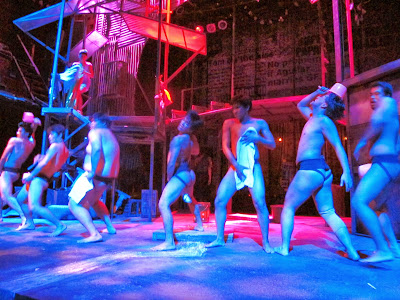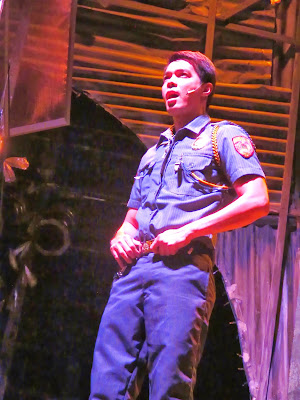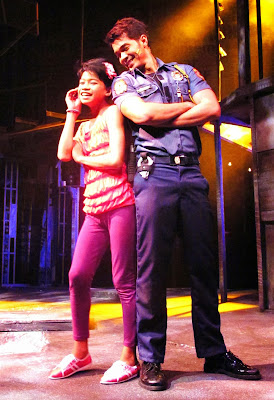When Ang
Pagdadalaga ni Maximo Oliveros (The Blossoming of Maximo Oliveros) was
shown in 2005, debuting at the first Cinemalaya Philippine Independent Film
Festival, it was groundbreaking. It was the first film to delve into the life
of a preteen gay boy as he comes of age in the slums of Manila, deftly and
sensitively capturing a uniquely gay experience as well as plumbing universally
human emotions.
Although the directing was a tad stilted and
“crude,” I remember being amazed by the film, one of the saddest and most
beautiful coming-of-age stories I have ever seen with the brilliance of the
screenplay, wrought by Michiko Yamamoto, who also wrote Magnifico (2003) and Zombadings
1: Patayin sa Shokot si Remington (2011), shining through.
The digital movie, the feature film debut of
director Auraeus Solito produced by ufo Pictures, also caught the attention of
critics and film buffs that it was chosen as the Philippines’ official entry to
the foreign-language film category of the 2007 Academy Awards, and the most
outstanding film of the year at the 2006 Gawad Urian, the country’s most
respected award for movies. It also reaped honors at several international film
festivals including the Best Film at the 2005 Asian Festival of First Films;
the Best Picture at the 2005 Toronto Imagine Native Film Festival; the Golden
Zenith Award for Best Picture at the 2005 Montreal World Film Festival; the
Teddy Award and Glass Bear Special Mention at the 2006 Berlin International
Film Festival; and the Independent Spirit Award from the 2007 IFC Spirit
Awards. It charmed audiences that it quickly became a gay classic movie.
 |
| The Santo Nino procession scene |
 |
| The Santo Nino procession scene |
 |
| The Santo Nino procession scene |
 |
| The Santo Nino procession scene |
 |
| Neighborhood men dancing |
 |
| Scene of policemen and prisoners bathing |
 |
| Scene of policemen and prisoners bathing |
 |
| Scene of policemen and prisoners bathing |
 |
| Community protests eviction notices |
 |
| One the last scenes: Maxie goes to school, notices and then ignores Victor. |
 |
| The Santo Nino procession |
Now, the story of Maximo Oliveros, nicknamed
Maxie, continues to charm and evolve with a new stage musical adaptation, Maxie the Musicale: Ang Pagdadalaga ni
Maximo Oliveros, which started showing on November 9, 2013, and runs for
only 18 performances until December 8 at the Philippine Educational Theater
Association (PETA) Theater Center in New Manila, Quezon City.
The musical is being produced by a relatively
new company, the Bit by Bit Co., in cooperation with the PETA Theater Center
and the Cultural Center of the Philippines (CCP). Founded in 2006, Bit by Bit
Company describes itself as a leisure, wellness and entertainment company, but
its heads were smitten by theater that they are now into producing and
promoting plays.
Darwin Mariano, a lawyer and the play’s
executive producer, recalled being inspired going into theater upon watching a
staging of Francisco Balagtas’s lesser known but scintillating work, the komedya Orosman at Zafira, by the
Dulaang UP (University of the Philippines). Orosman
was staged in 2008 for UP’s Komedya
Festival and was restaged in 2010. Bit by Bit reproduced it in 2011 at the SM
Mall of Asia in Pasay City, and it was during this time the idea for Maxie the Musicale was born.
“After watching one of the performances, we
asked our friend and one of the original filmmakers, Jade Castro, if we could
adopt his film Endo for the stage.
Jade suggested that the better project would be to turn Ang Pagdadalaga ni Maximo Oliveros into a musical,” Mariano wrote
in the playbill and would recount in several events promoting the play.
Castro said when they were making the movie it
crossed their minds that Maximo will
lend itself well to a musical.
Mariano considered this as go signal and, with
Carlo Miguel Francia as associate producer, whole-heartedly plunged into the
project, even mortgaging their own house just to make it happen, he said. He
got Dexter Santos to direct it. A Theater Arts graduate and a professor at UP,
Santos was the director of the UP Orosman
and other plays of Dulaang UP and other companies such as the New Voice
Company, Repertory Philippines and Tanghalang Ateneo. Also a choreographer, he
did the dance steps for Maxie the Musical.
For the adaptation of the movie and the writing
of the book and lyrics, the filmmakers suggested multiple Palanca-award winner,
lawyer, poet and playwright Nicolas Pichay, who had a slew of notable works for
the stage, including the prize-winning The
Slanting Dance of the Buliklik Hawks, a stage adaptation of the Ifugao hudhud chants, and Almanac for a Revolution. The production would describe the
adaptation as “based on Michiko Yamamoto’s screenplay…later made into a film
directed by Auraeus Solito.”
“It’s like the movie but it’s not the movie,”
Pichay would enigmatically say.
He explained that all the elements people love
about the film are present but with the interpretations of and insights from
the new set of artists involved in the musical. The initial drafts of the
adaptation proved to be unwieldy and he constantly revised it, taking heed from
the comments and suggestions of others in the production. The final version is
the tenth revision, Pichay revealed.
“Wala
kaming ambisyong tapatan (We never dreamed of replicating) what Maxie did for and means to many people,”
Mariano said. The musical adaptation is more of a celebration of the film, he
added.
Finding other artists to tap for the other
aspects of the production became daunting, especially in the crafting of the
music.
“We didn’t want Maxie to sound like anything the audiences have heard before. It
had to sound innocent, angry and hopeful all at the same time, while not
deviating from what Sampaloc sounded like. After putting together a much longer
list, we chose William, JJ and Janine, knowing each would bring their distinct
musical identities and influences into the project. We knew they were talented,
but we were not prepared for music this amazing and this unforgettable,”
Mariano related.
William Elvin Manzano has been working in
theater but started writing music in 2011. He has a band called Happy Days
Ahead that has produced two independent albums. Hailing from Baguio City, JJ
Pimpinio had a business degree but has been into theater and music. On the
other hand, Janine Santos is a classical opera singer and has been working in
theater as musical director, vocal coach and composer.
The composers created songs in different
musical styles, which become evident when differentiating characters. They said
they got inspiration from the sounds being played and heard in Sampaloc, the
district in Manila in which the story is set. So there is the Manila sound or
disco-inspired 1970s music, rock, pop and rhythm and blues. OPM (original Pilipino music) is the primary
influence.
In early 2013, the company began a series of
auditions, especially for the roles of the two main characters, the twelve-year-old,
effeminate Maximo, and the handsome and young police rookie Victor, the object
of Maximo’s love. By April, they had found someone to play the role of Maxie,
fourteen-year-old Jayvhot Galang from Santa Ana, Manila. Galang has been doing
the rounds of amateur singing contests and television searches with a
predilection for belting songs like the late singer Whitney Houston. When the
producers saw an online clip of him singing, they sought him out and invited
him to audition. Without any previous theater experience, Galang was enrolled in
the PETA summer acting workshop. In the last five months, he also took up
aerobics exercises, dance classes and voice lessons under Santos while
attending regular classes in high school.
 |
| Fourteen-year-old Jayvhot Galang plays Maxie |
 |
| Maxie with father and two brothers, petty criminals who love and protests him, a subversion of reality and perception |
 |
| Maxie and his posse. |
Around May, the role of Victor was given to
Jojo Riguerra, architect who turned stage actor, singer and model.
On August 23, Bit by Bit gave a foretaste to a
small group of people through “Patikim ng
Shlight: Maxie the Musicale Kick-Off” at the Tanghalang Huseng Batute of
the CCP, with Kristine Joan Villanueva, Janine Santos, JC Santos, Pimpinio,
Jules dela Paz, Neil Tolentino, Via Antonio and Manzano rendering select songs
for thirty minutes. Already, many people were hailing Maxie the Musicale to be the theater event of the year.
By that time, the cast and crew was almost complete.
The actors included Roeder Camañag and Nazer Salcedo (Paco), Al Gatmaitan and
OJ Mariano (Boy), Jay Gonzaga (Bogs), Aaron Ching (Nar), Teetin Villanueva
(Monique), Nomer Limatog Jr. (Leslie), Greg de Leon (Chief Dominguez), Eo de
Guzman and Merdin Mojica (Peter), with an ensemble composed of Ruth Alferez,
John Paul Basco, Jules de la Paz, Irene Delarmente, Elliot Eustacio, Karyl Anne
Factora, Jim Andrew Ferrer, Francelle Fetalvero, Al Bernard Garcia, Jeffrey
Hernandez, Ronah Rostata and Christian Velarde.
On the other hand, the artistic crew included
Gino Gonzales (production designer), John Batalla (lights designer), Ohm David
(technical director), Emman Feliciano (assistant director), Stephen Viñas
(associate choreographer) and Arkel Mendoza (additional music). The band is
composed of William Elvin Manzano and Rigil Borromeo (guitar), Van Quiaong and
Bryan Sapigao (piano), Jonah Ruiz (drums), Jon Abella (acoustic guitar) and
Charlene Allen Mamaid (bass), with Santos as musical director.
“Patikim
ng Shlight” fulfils its promise with an exuberant flowering. Maxie the Musicale remains faithful to
the screenplay but with flourishes of its own, most of them created to the
exigencies of musical theater. These are difficult, if at all, to do in film
without undermining its seriousness and sincerity, but the story has a
poignancy that is almost innate and hard to dilute. The musical opens with an
extravaganza, introducing and attempting to recreate a Sampaloc slum community.
From the writer, director to the composers, there is an expressed desire to
define Sampaloc and bring it to life onstage with its squalor, contradictions,
grime and redeeming aspects, a thing hard to do in theater with its limitations
that can render location non-specific and illusory, the apparent artifice and
with the creators’ own romanticizations of poverty.
 |
| Jojo Riguerra plays handsome cop Victor |
 |
| Victor confronts two thuds who molested Maxie |
Gonzales’s set design is an assemblage of
corrugated iron sheets, plywood and rough shafts of wood, carefully arranged to
seem disorderly. The rafter is strewn with laundry.
The opening number sees the community in
Sampaloc waking up to a new day, revealing its denizens of different types and
singing, “Kumunoy ang takbo/ng buhay sa
paligid/Ang lahat ng ganda/kinakain ng limahid/Ang buhay dito, iba’t iba ang
hugis/Bahaghari ang kulay ng saya/at pantutugis.” Maxie is also introduced,
girlish and well-accepted by the community, which says, “Ngunit may isang beki/na sa ami’y kering-keri/mabait at super
lovely/mahinhin at very friendly/maalaga parang mommy.” He is with his barkada composed of two other gay kids,
Nar and Leslie, and a fag hag, Monique. His friends have more scenes in the
play than in the movie, accompanying Maxie almost throughout the journey.
Also introduced is Maxie’s family, his father
Paco and two brothers Boy and Bogs, who are involved in stealing and selling
cell phones and operating an illegal jueteng
gambling venture. Despite being thugs, they are protective of and loving to
Maxie, who serves as mother, cooking dishes and doing the laundry. This is one
endearing and inspiring aspect of the story, a sharp subversion of the reality
of gay kids being bullied and rejected by their own families.
One night, two men attempt to molest Maxie but
is saved by the new cop Victor, caring, honest and upstanding, unlike anyone
the community has ever encountered. He resists being bribed even by Maxie’s
father, who predicts he will eventually succumb to corruption. Maxie soon
develops a powerful crush on the good-looking Victor. They develop an
extraordinary and sweet friendship, but conflicts begin to arise that see Maxie
being torn between his love for the police officer dedicated to his duty and
his loyalty to his family of petty criminals. Conflicts escalate when Boy stabs
a girl to death when a robbery goes awry and Victor is bent on finding the
offender. At its height, Victor is forced to kill Paco in a confrontation.
Their situation is evocative of Romeo and
Juliet but not quite Romeo-and-Juliet. I believe Maxie’s story is more
complex and nuanced.
The stirring and painful moments are
interspersed with exhilarating and uproarious musical numbers. There is a
procession in honor of the Santo Niño, with Santo Niño images dressed in
different costumes, including an astronaut’s, indicating its similarities to
drag shows. Policemen and prisoners have a number during a shower scene, more
risible than titillating. There is an amusing segment showing the showy
embodiments of Maxie’s fantasies involving him and Victor, such as Victor
slaying monsters to save little princess Maxie. But the most rollicking and
popular is the beaucon (beauty
contest). What starts as a child’s play in the movie transmogrifies into a
full-blown spectacle, with Nar, Leslie, Monique and Maxie trying to outdo one
another in the talent portion. The musical can actually do without them but
they are much fun and they add to the campiness integral to Filipino gay
culture, which the main character is part of and the musical wants to depict.
These entertaining segments are counterbalanced
by the injection of social commentary such as the scene of demolition of
shanties and the people’s defiance.
 |
| Victor carries Maxie home after saving him from two bullies |
 |
| Maxie fantasizes about the brave Victor saving him, the princess in distress, from monsters. |
 |
| Maxie and Victor eat out at a food vendor's ambulant stall |
 |
| Maxie comforts Victor after being mugged by his two brothers. |
 |
| Maxie meets Victor for the first time. |
But at the heart of all these is Maxie and
Victor. Galang portrays Maxie with considerable competence, although the voice
can falter at heart-rending moments and his natural “playfulness” sometimes
threatens to dissipate the character Maxie’s innocence and lovable naivety,
which is the strength of Nathan Lopez’s portrayal in the film. Riguerra is more
rugged in looks than the original Victor, the boyish and disarming JR Valentin.
But both have their own ways of weakening the knees, taking the breath and
touching the heart in the most nonchalant ways.
Their story is a flower, impossibly beautiful
and impossibly evanescent, always threatened from the outside and from within.
Ang
Pagdadalaga ni Maximo Oliveros is in the heart of the gays of this generation
and will be in the hearts of generations to come. It is extends beyond this
time and reaches out any gender group, because it is great, it is art, a
beautiful blossoming in the dark of the theater and in the dark of the world.
Maxie the
Musicale: Ang Pagdadalaga ni Maximo Oliveros runs from November 9 to December 8,
with shows on Fridays, Saturdays and Sundays at 8 P.M. and matinee shows on
Saturdays and Sundays at 3 P.M. All performances are at the PETA Theater
Center, 5 Eymard Drive, New Manila, Quezon City. For show information, call
0917-8427346 or email maximooliverosmusical@yahoo.com. Follow Maxie on Twitter (@MaxieTheMusicale) or
visit www.facebook.com/MaxieTheMusicale on Facebook. Tickets are available at
all TicketWorld (891-9999) and SM Tickets (470-2222) outlets.



































